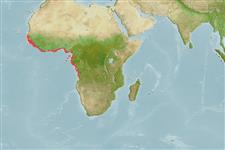Common names from other countries
Environment: milieu / climate zone / depth range / distribution range
Écologie
Benthopélagique; saumâtre; profondeur 3 - 740 m (Ref. 105050). Tropical; 16°N - 17°S, 18°W - 14°E
Distribution
Pays | Zones FAO | Écosystèmes | Occurrences | Introductions
Eastern Atlantic: along West African coast, from Senegal to Angola.
Length at first maturity / Taille / Poids / Âge
Maturity: Lm ? range ? - ? cm Max length : 7.5 cm TL mâle / non sexé; (Ref. 434)
Pelagic (Ref. 105112). Exploited in the continental shelf (Ref. 121688). Inshore, prefers high salinity river mouths (Ref. 121669). Also found on sandy and muddy bottoms in estuarine and coastal marine waters to depths of about 50 m (Ref. 434). Mainly feeds on mysids and copepods. Preyed upon by fish and decapods (Ref. 105112).
Life cycle and mating behavior
Maturité | Reproduction | Frai | Œufs | Fécondité | Larves
Members of the order Decapoda are mostly gonochoric. Mating behavior: Precopulatory courtship ritual is common (through olfactory and tactile cues); usually indirect sperm transfer.
Fischer, W., G. Bianchi and W.B. Scott (eds.). 1981. (Ref. 434)
Statut dans la liste rouge de l'IUCN (Ref. 130435)
statut CITES (Ref. 108899)
Not Evaluated
Not Evaluated
Utilisations par l'homme
Pêcheries: commercial
FAO - pêcheries: landings | FishSource |
Outils
Sources Internet
Estimates based on models
Preferred temperature
(Ref.
115969): 11 - 16.4, mean 14.2 (based on 40 cells).
Vulnérabilité
Low vulnerability (10 of 100).
